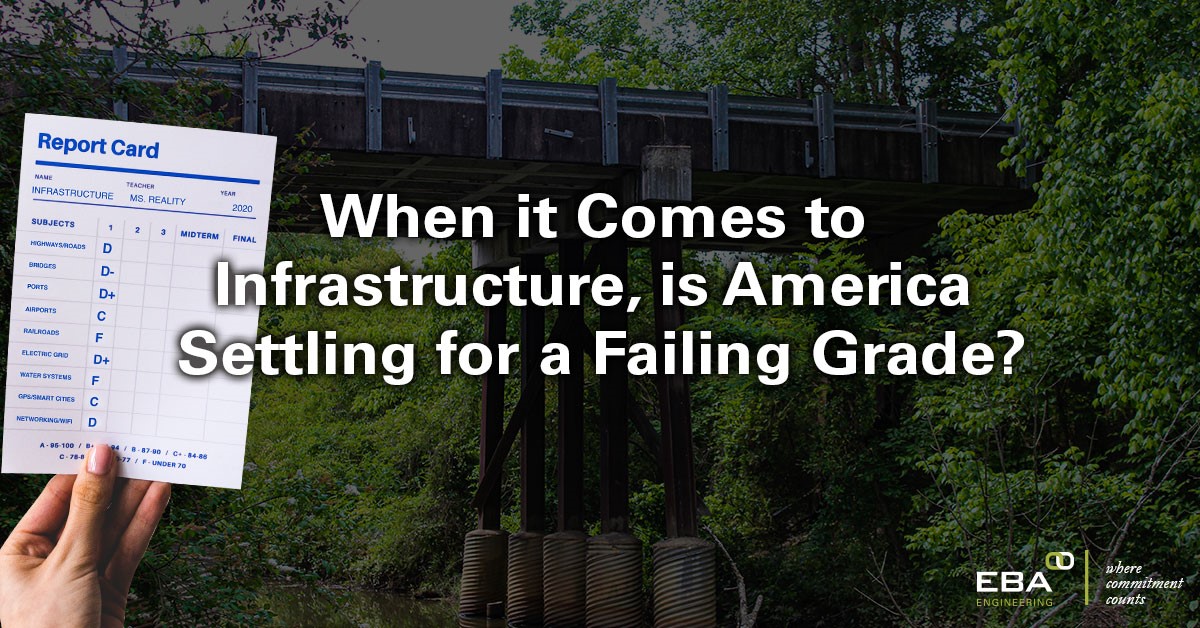When it Comes to Infrastructure, is America Settling for a Failing Grade?

Every family, community, and business in the United States relies on our infrastructure to operate and prosper. What many of us do not realize, however, is that the U.S. is actually headed down a path toward failing utility systems, impassable roadways due to disrepair, crumbling bridges, and electricity blackouts in our nation’s cities.
Every 4 years, the American Society of Civil Engineers (ASCE) provides a comprehensive assessment of the nation’s major infrastructure. Known as the Infrastructure Report Card, this evaluation uses a school report card format (where “A” is exceptional and “F” is failing) to assess the current conditions and needs of the nation’s 16 major infrastructure categories. The report both assigns grades and offers recommendations for raising those the grades.
Since the first Report Card on America’s Infrastructure was issued in 1998, delayed maintenance and underinvestment in infrastructure have landed the U.S. with near-failing grades, averaging only Ds. The report is clear that America’s aging infrastructure is inadequate and becoming unsafe. We are settling for less than we deserve, and the depressing truth is that, without drastic intervention, the nation inevitably faces an infrastructure disaster.
The most recent (2017) Infrastructure Report Card rates America’s overall infrastructure score at a D+. On the state level, Maryland (C), Virginia (C-), Pennsylvania (C-), and DC (C-) are currently rated a bit higher than the national average, between mediocre and poor.
Like many modern conveniences, the average person probably does not think much about infrastructure until it does not work. Perhaps this is one reason why infrastructure spending and maintenance has not been a government priority in recent years.
America’s two greatest booms in infrastructure spending in the past century were during the Great Depression, and then later in the 1950s-60s to construct most of the interstate highway system. Since then, public infrastructure spending as a share of GDP has declined as the federal government has prioritized other areas.
According to the Harvard Business Review, since the 1960s, “other countries surpassed the U.S. in ease of getting around, which has implications for businesses and quality of life. For example, Japan just celebrated the 50th anniversary of its famed bullet train network, the Shinkansen. Those trains routinely operate at speeds of 150 to 200 miles per hour.” Test runs for Japan’s bullet trains had reached 275 mph, and the average deviation from schedule is only 36 seconds! Meanwhile, America’s “high-speed” trains are nowhere near as fast because they must navigate tracks laid over a century ago with aging components.
To get a better picture of the challenges we face, let’s look more closely at just some of our major infrastructure categories.
Roads. According to ASCE, more than 40 percent of every 5 miles of America’s urban interstates are congested, and in 2014, traffic delays cost the country $160 billion in wasted time and fuel. One out of every 5 miles of highway pavement is in poor condition, and our roads have a significant and increasing backlog of rehabilitation needs.
Bridges. In 2016, 9.1 percent of the nation’s bridges were rated as structurally deficient. We have 614,387 bridges in our nation, 4 in 10 of which are 50 years or older. The life expectancy of bridges is 50 years, and they are over or approaching the end of their design life.
Drinking water. Much of our drinking water infrastructure is also nearing the end of its useful life. An estimated 240,000 water main breaks occur every year in the United States. Just one dramatic incident occurred in 2008 when motorists had to be rescued by boat and helicopter from a torrent of water on River Road in Bethesda, Maryland, after a 66-inch water main burst. According to the American Water Works Association (AWWA), the cost could reach more than $1 trillion to meet drinking water demands over the next 25 years.
Electric grid. Although we cannot imagine life without electricity, one of the most outdated and overburdened parts of America’s infrastructure is the electrical grid. Whether preparing meals and refrigerating food; powering our hospitals and workplaces; or keeping the lights, air conditioning, and Internet access on, electricity literally powers every moment of our daily lives. Yet, some of the U.S. electric grids were built back in 1880s!
In international rankings, the United States fell to 13th globally in quality of infrastructure according to the World Economic Forum’s 2019 Global Competitiveness Report.
Rescuing our infrastructure will take, above all else, an increased monetary investment. The 2017 Infrastructure Report Card recommends increasing investment levels to between 2.5 and 3.5 percent of U.S. GDP by 2025.
The 2013 report card suggested that an estimated investment of $3.6 trillion was needed by 2020 to keep ports, highways, bridges, trains, water, and electric facilities up to date. Yet ASCE says that the U.S. has funded only $1.88 trillion of that, and the shortfall will rise to $5.18 trillion through 2040 without new funding commitments.
If America hopes for a better grade on our next report card in March 2021, we must commit to better awareness and better funding immediately.
